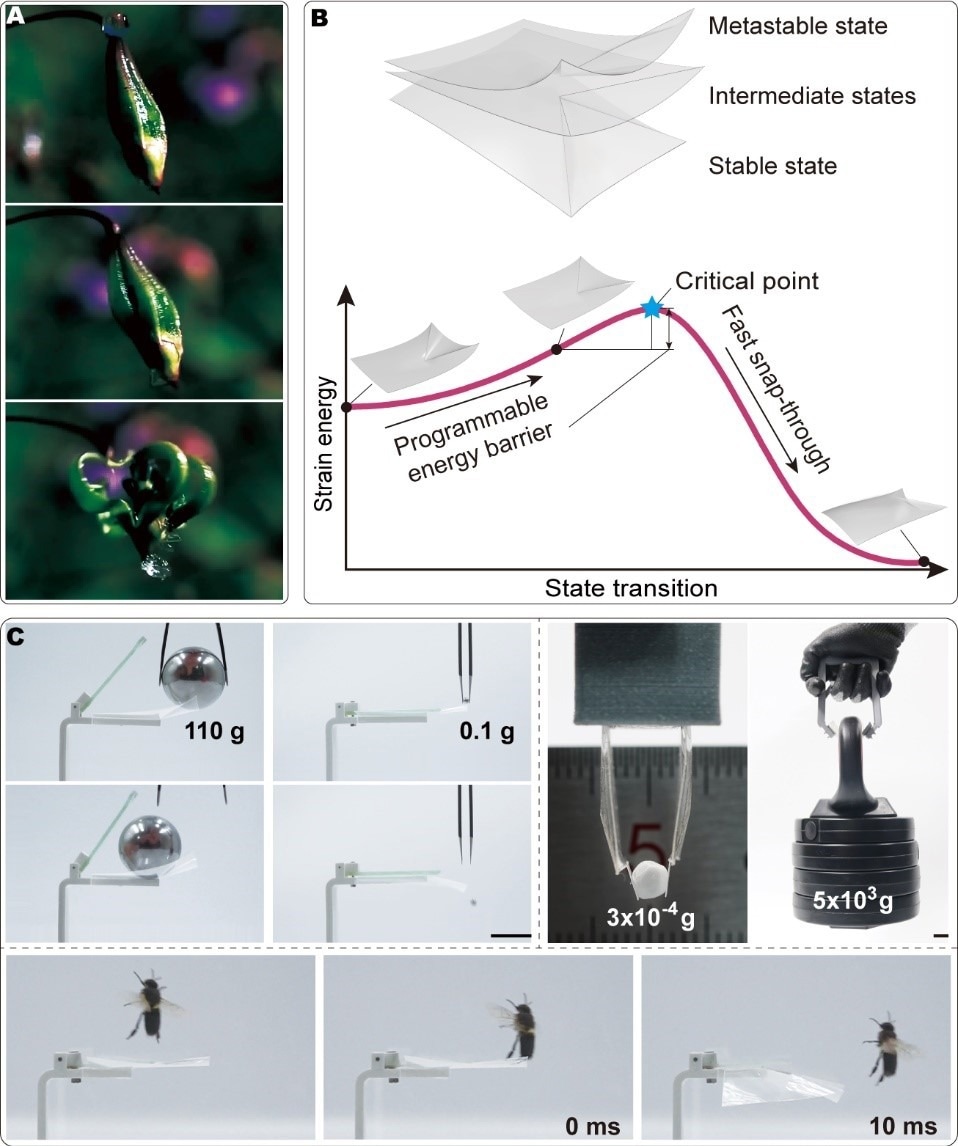Bistable structures in nature are unique in terms of their rapid response and force amplification even with the slightest physical stimulation.

Schematic of the proposed ultra-tunable bistable structure. (Image Credit: Yingtian Li).
Harnessing bistability and instability to quickly release the stored energy in bistable structures could improve robot performance in several areas, e.g., high-speed locomotion, adaptive sensing, and fast grasping.
Yet, current literature on bistable structures tends to focus on their stable states, while intermediate states with a large range of tunable energy barriers are ignored.
Recently, a research group headed by Dr. Yingtian Li from the Shenzhen Institute of Advanced Technology (SIAT) of the Chinese Academy of Sciences has suggested a kind of ultra-tunable bistable structure with programable energy barriers and activated forces of orders of magnitude differences.
The structures could also be tailored with altered geometric configurations, materials, dimensions, and actuation techniques for several robotic applications.
This study was reported in the Cell Reports Physical Science journal on April 18th, 2023.
The reported bistable structure was fabricated by folding a sheet material in a particular crease pattern.
It holds a metastable state, a stable state, and a huge number of intermediate states.
When the bistable structure transitions from its metastable state to the stable state, there is a critical moment where the stored strain energy reaches its maximum value, and the fast snap-through starts.
In this study, the enormous intermediate states with programmable energy barriers before the bistable structure reaches its critical point were reported.
By altering the structure from the metastable state to any intermediate state, there is a decrease in the energy barrier, thereby implying that smaller external stimulations are needed to activate the fast snap-through of the bistable structures.
As the energy barrier keeps reducing, the required external stimulation becomes more and more sensitive. That is how the scientists acheived a huge range of adjustable trigger forces for the suggested controllable bistable structure.
To illustrate the tuneability of the proposed structure, scientists performed a range of experiments and demonstrated that the trigger force of a single structure can be tuned to 0.1% of its maximum value, while the lifted weight difference was around 107 times greater when using grippers fabricated by the proposed structures with different design parameters.
We can tune the structure to an ultra-sensitive state so that it will respond to a minute stimulation as gentle as a touch of a flying bee, while we could also set the structure to an insensitive state that even a steal ball weighing 110g could not break its energy barrier.
Dr. Yingtian Li, Shenzhen Institute of Advanced Technology, Chinese Academy of Sciences
To confirm the potential of the structure in different applications, several prototypes were developed, such as a jumper, grippers, a robotic flytrap, a swimmer, a thermal switch, and a sorting system.
The prototypes illustrate that the robotic flytrap with a sensitive “pistil” could be activated by physical stimulation in 10 milliseconds; the bistable catcher has the potential to capture a high-speed (10 m/second) table tennis ball; and the least jumper achieves a height of more than 24 times its body height, etc.
We are happy to find out our proposed structure could be used in such a wide range of applications, which demonstrates superior performances. This work could broaden the frontiers of bistable structure design and lead a way to future designs in robotics, biomedical engineering, architecture, and kinetic art.
Dr. Yingtian Li, Shenzhen Institute of Advanced Technology, Chinese Academy of Sciences
Demonstration of ultra-sensitive force detection and fast response properties. The proposed structure can be triggered by a droplet and flying bees when adjusted to intermediate states with super-low energy barriers. (Video Credit: Yingtian Li).
Journal Reference:
Jiang, Y., et al. (2023) Ultra-tunable bistable structures for universal robotic applications. Cell Reports Physical Science. doi.org/10.1016/j.xcrp.2023.101365.